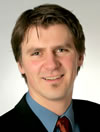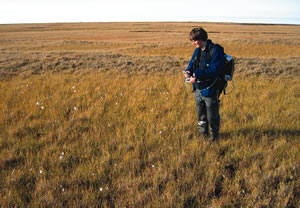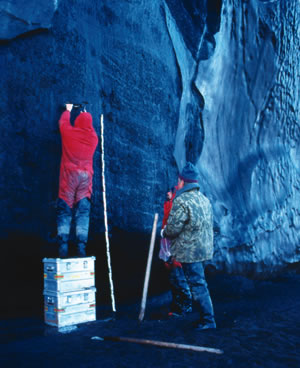UAF IPY postdoctoral fellows
GUIDO GROSSE
by Jenn Wagaman, UAF Center for Research Services

GEOLOGY
Alfred Wegener Institute for Polar and Marine Research, Germany
POSTDOCTORAL RESEARCH
The degradation of permafrost in the Arctic due to climate change, using remote sensing, spatial data analysis and other methods
MENTOR
Vladimir Romanovsky
UAF, Geophysical Institute
HOMETOWN
Potsdam, Germany
WHY SCIENCE?
"Four simple words: discovery, exploration, expeditions and fun."


Guido Grosse is living his dream. The German-born geologist can't remember a time when he didn't want to be a scientist, and now he's living on the edge of the Arctic, researching permafrost during the International Polar Year. He's also just become the proud father of his first son.
"I think I can say that I always wanted to be a scientist and I'm glad to be one," says Grosse. "Studying geology is a good way to satisfy my goals to explore things related to the Earth and figure out how things work. I don't think I would change a thing."
Grosse is at the University of Alaska Fairbanks studying changes in permafrost distribution in arctic regions. Permafrost, or permanently frozen ground, covers a huge area of the northern hemisphere land surface--approximately one-quarter of it--including large regions of Alaska, Canada and Siberia, as well as some Central Asian mountain regions. Permafrost has major impacts not only on the ecological systems of these areas, but also on the people who live and build on the land.
"I use remote sensing with satellite data to detect, map, classify and quantify characteristics of permafrost landscapes and the natural and human-related degradation of permafrost," says Grosse. "One of the features of permafrost degradation is thermokarst, which results in the large basins and lakes that form in the arctic lowlands of Alaska or Siberia. It also affects vegetation and surface hydrology, which has many ecological and economic impacts."
In other words, the more permafrost thaws, the more changes Alaskans may see in the types of plants that grow on the land, and thus the kinds of animals that can survive on that land. This could have major implications for the people who rely on subsistence activities for their livelihoods, as well as where and how we build homes, buildings and pipelines.
Grosse's work will contribute to a worldwide effort to understand what is currently happening to the permafrost and provide a database for future researchers to compare their own work to Grosse's, like a snapshot in time.
It's an exciting time to be a polar researcher because of IPY, and because there is so much to learn. "We probably know more about the Martian surface than about some of the remote polar regions of the world," he notes.
To have a lasting impact on the world, Grosse believes he is perfectly positioned as a scientist. "Science for the first time understands that people who are living in the North are also the first to experience massive environmental change in their own regions," says Grosse. "To discover or invent something exciting or useful for me is the most rewarding aspect of being a scientist."
So why Alaska?
"The university is situated right at the doorstep of the Arctic. That's so unique," says Grosse. "And we have the highest concentration of researchers focusing on arctic themes ranging from geosciences to biosciences, atmospheric sciences, even social sciences and space. That is a really unique concentration of experts that I can collaborate with."
Images courtesy Guido Grosse unless otherwise noted


